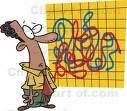The point I was trying to make was missed; yes, if only adjusting the stock tensioner is what you're trying to do, then having it on the 'C' mark is critical because that is where Yamaha engineers calculated the maximum slack in the chain will be. Remember, the OEM tensioner (while having a spring to 'adjust' it), once adjusted and locked down with the bolt doesn't move. Which is why it needs periodic adjustment. 
I'd suggest a careful reading of the FSM, 'engine assembly and adjustment, parts I and J', starting on page 3-45. Note that they start with the 'T' mark and end with it. The motor is turned to the 'C' mark merely to try to get the most slack in the chain at the tensioner. As the ACCT 'self-adjusts', a few hand rotations of the motor will do that without ever stopping at 'C'....
Personally, if removing/reinstalling any CCT, I'd pull both the timing and cam covers to verify cam timing in any case as per the FSM.

I'd suggest a careful reading of the FSM, 'engine assembly and adjustment, parts I and J', starting on page 3-45. Note that they start with the 'T' mark and end with it. The motor is turned to the 'C' mark merely to try to get the most slack in the chain at the tensioner. As the ACCT 'self-adjusts', a few hand rotations of the motor will do that without ever stopping at 'C'....
Personally, if removing/reinstalling any CCT, I'd pull both the timing and cam covers to verify cam timing in any case as per the FSM.




Comment